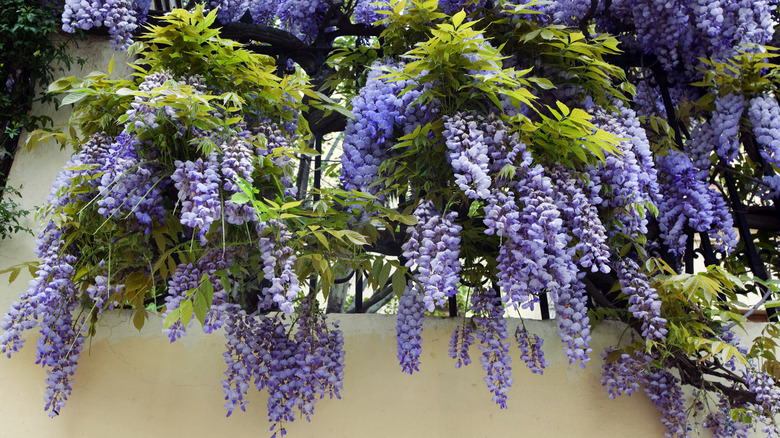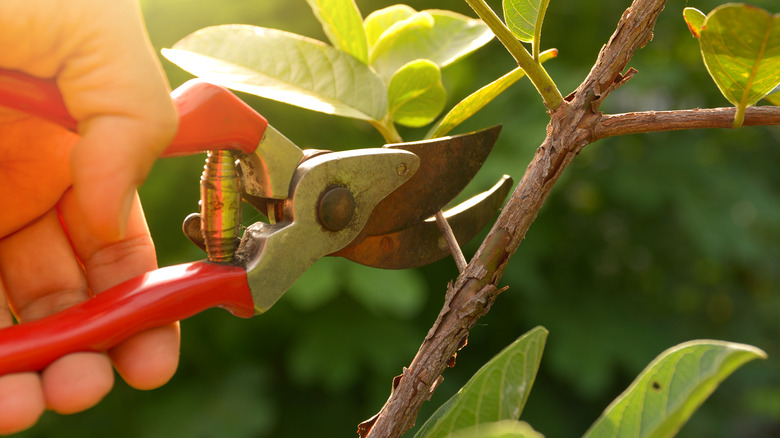How To Get Rid Of Wisteria If It Takes Over Your Garden
The dual nature of wisteria means that, as much as its aesthetic appeal might lure you, you may also find yourself grappling with an invasive problem before you know it. Wisteria may quickly out-compete other plants in your landscape, even enormous trees, and can even begin to climb and engulf buildings, including your home, if left unchecked. Depending on whether you want to completely remove it or just manage its growth, there are efficient techniques to deal with this tenacious plant, such as chopping and painting.
Also, note that there are different types of wisteria, such as Chinese, Japanese, and American. Chinese wisteria is the most common and is noted for its vigorous growth and robust flowering. Its ability to grow rapidly can make it invasive, so it requires careful management. Japanese wisteria is known for its longer, more pendulous flower clusters and has a slightly slower growth habit than its Chinese counterpart. American Wisteria is native to the United States and is the least aggressive of the three major types, making it a good option for those looking for a more manageable vine. It is also the most tolerant of different soil and climatic conditions and has smaller, more compact flower clusters than either the Chinese or Japanese varieties.
Eliminating invasive wisteria: cut, paint, and dispose
To eliminate invasive wisteria effectively, you can cut off the vines and then "paint" the freshly cut stem with a herbicide solution that contains 25% glyphosate. This systemic herbicide is designed to travel all the way down to the roots, thereby killing the entire plant from the inside out. But proceed with caution; this is not a task to be taken lightly. The herbicide is potent, so avoid spraying it to minimize the risk of damaging other nearby plants.
Adhere strictly to the instructions provided with the product for the proper application method. The ideal time for this operation is during the late summer or fall when the wisteria plant is actively transporting nutrients to its roots. This timing ensures the herbicide is most efficiently absorbed and channeled to the root system, guaranteeing a thorough kill of the plant.
One crucial point to remember is that wisteria has multiple methods of propagation, such as seeds or rooted stolons. Because of this, the way you dispose of the cut vines becomes highly important for preventing future growth. The safest and most effective way to dispose of the vines is to bag them up securely and take them to a specialized waste facility. Avoid the temptation to compost these cuttings, as this could inadvertently lead to a resurgence of the invasive species. Exercise diligence at each step to ensure you don't unintentionally cause more harm than good.
Controlling wisteria: prune regularly and ruthlessly
Maintaining control over your wisteria requires a level of diligence and frequent attention, but the effort pays off. One of the most effective ways to keep wisteria under control is through a well-planned pruning schedule. During the summer months, you must keep the vine's growth in balance. Make it a routine to lightly trim away any unruly shoots or invasive tendrils and nip new sprouts in the bud before they get a chance to establish themselves. This kind of regular summer garden maintenance is crucial for preventing the wisteria from overwhelming other plants in your garden or encroaching on nearby structures like fences or pergolas.
However, your pruning duties don't end with the summer. When winter or late fall comes, it's time for a more extensive pruning session. During this period, you should trim back the side branches. Also, take the time to identify and remove any dead or dying branches. This not only keeps the vine at a manageable size but also sets the stage for healthy flowering in the upcoming season. The winter pruning allows you to shape the vine and guide its growth, ensuring that it adds beauty to your garden without becoming a hindrance. With these timely and consistent pruning measures, you create a harmonious balance between allowing your wisteria to flourish and keeping it well-contained.


